Kensington, the section of Brooklyn located just south of Windsor Terrace, SW of Prospect Park and SE of Green-Wood Cemetery, is named for a western borough of London — many streets in Prospect Park South were given British names by Prospect Park South‘s developer, Dean Alvord, during the early 20th Century.
Kensington lies near Bay Ridge and Borough Park, and so I have always had a familiarity with it from my days of cycling through Brooklyn from my Bay Ridge home. I filed away a lot of meterial in my head from that era, roughly 1973-1993, when preparing Forgotten New York, the website and later the book.
There are a number of short streets within the neighborhood (differentiating it from neighbors Sunset Park and Borough Park, and likening it to Flatbush, which borders it on the east). Neither alleys nor main streets, they run for one block, two at the most, and some bear hidden delights.
TODAY’S WALK ROUTE: Kensington Lanes
Kermit Place/Caton Place/Friel Place
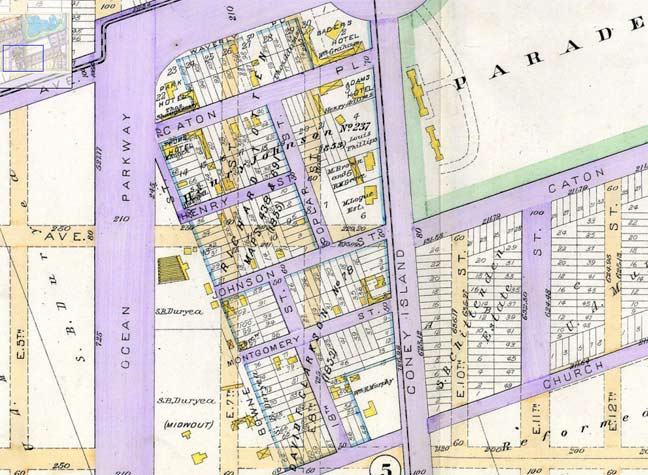
The part of Kensington found between Ocean Parkway, Coney Island Avenue and Church Avenue is curious. It seems to predate the surrounding checkerboard street grid, its streets are narrower and the atmosphere generally different. Signs point to it being developed earlier than the rest of Kensington.
On the 1890 atlas above, the earliest one I can readily find of this area. Most of the streets shown are still there. The purple color of the roads gives evidence that they had already been paved (with concrete blocks or macadam) and the small yellow rectangles along the streets show that homes and buildings had ben built, as well. By contrast see the eastern part of the map, south of the Parade Ground, where there’s still nothing.
Today, Caton Place is still so named, but Henry Street is Kermit Place, Johnson Street has become Caton Avenue, and Montgomery Street is now Friel Place (so renamed in 1933 for a recently deceased alderman). Looking north to south, 18th Street (an odd extension of the 18th Street of Park Slope) and Poplar Street have both been renamed East 8th Street. Bowne Street has been obliterated completely.

By 1929, when this plate was surveyed, things had pretty much settled in to what they look like today, though the Prospect Expressway was extended along Ocean Parkway by Robert Moses in the early 1950s, and Caton Avenue was extended southeast from Ocean parkway to East 7th Street some time between 1929 and when I first encountered it as a boy riding in the B16 bus in the early 1960s. Kermit Place has also gained an eastern extension.
Kermit Place between Ocean Parkway and East 8th. While Avenue Q in Marine Park may have been renamed Quentin Road after Teddy Roosevelt’s son was killed during World War I (the odds are against it), I can’t be sure Kermit Place was named for another son of his, Kermit Roosevelt, soldier, businessman and, with his father, a South American explorer, and a 1943 suicide. Kermit Place had attained its name by 1929 so I doubt there is a connection, but you never know.
It row of attached homes, likely from the 1910s, give the eastern section of Kermit Place between east 8th and Coney Island Avenue an atmosphere all its own, as well as does a quirky slight bend in the road.

Though I bowled as a kid at Leemark Lanes on 88th Street between 4th and 5th Avenues, I also, now and then, came here to a lanes at Caton Place and East 8th. That was so long ago I can’t think of the name of the place, and Leemark, too, has disappeared. The Calvary Cathedral of Praise World Outreach Center has replaced strikes and spares. Top names in gospel music, including CeCe Winans, have appeared there.
[Park Circle Lanes — see comments]
I’d like to do a Remembrance of Bowling Alleys Past, if anyone remembers where they were.
Kensington Stables, Caton Place and East 8th, is one of two remaining stables in Brooklyn, joining the Jamaica Bay Riding Academy that serves the Shore Parkway area east of Flatbush Avenue. It gives Prospect Park one more stable than Central Park, whose Claremont Stables galloped away in the early 2000s.
Our barn at 51 Caton Place was built in 1930 as the last extension of the riding academy at 11 Ocean Parkway founded in 1917. The first extension was torn down to make the foot bridge over Ocean Parkway. The original riding academy closed in 1937 and is now a warehouse. Today, Kensington Stables is the only remaining stable in the Prospect Park area. We continue to offer friendly, accessible, and affordable equestrian activities for New Yorkers and New York’s many visitors from all walks of life. Kensington Stables
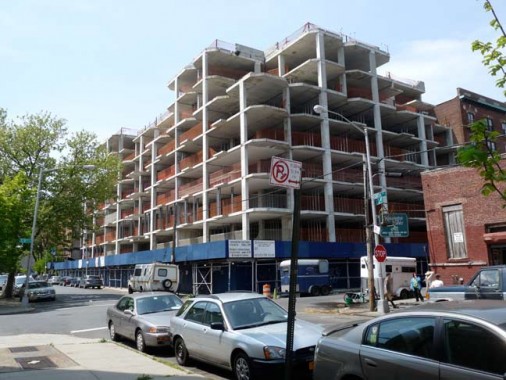
What will likely be an apartment building is rising across East 8th from the stables.
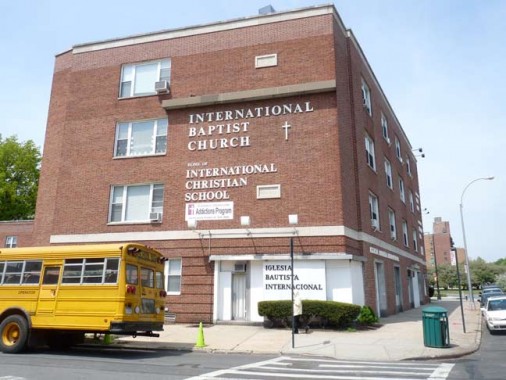
A second large church, International Baptist, is found at Caton Place and Coney Island Avenue across from the parade Grounds.
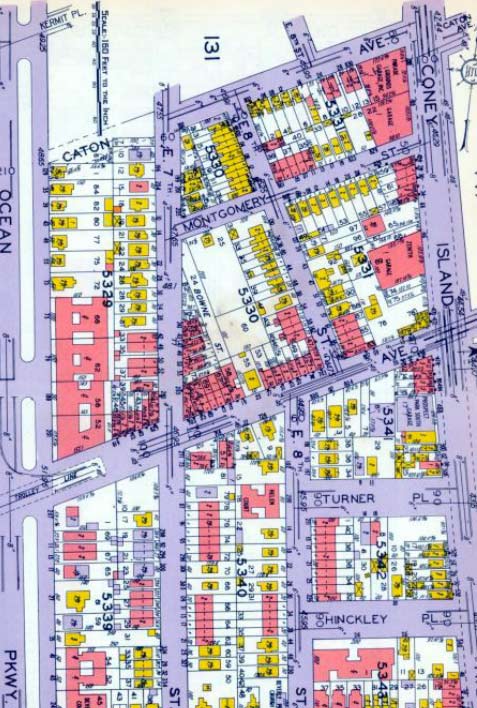
This excerpt from the 1929 atlas shows Montgomery Street, soon to be renamed Friel Place. Also shown are Turner and Hinckley Places, which are explored later in this entry.
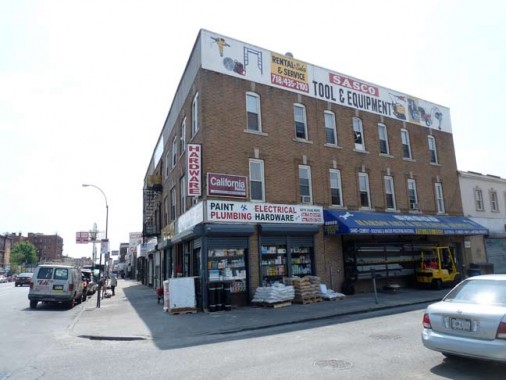
SW corner building at Coney Island Avenue and Friel Place — plenty of hardware store signage.
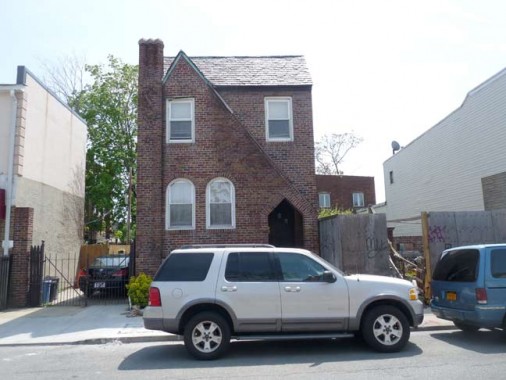
Tudor-ish building on Friel between East 8th and Coney Island Avenue appears to have been cut in half by a giant blade.
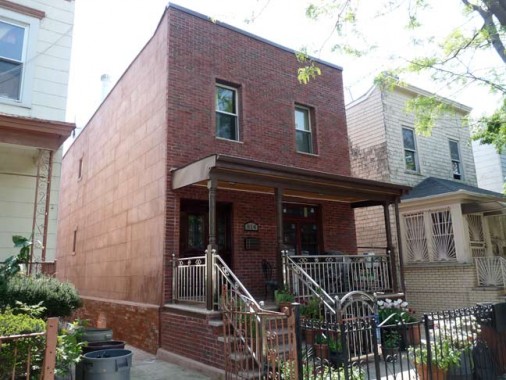
What is likely a near-century old salt box building has been given a makeover. Note the house number, 814, which reflects its proximity to East 8th. Other short lanes in the neighborhood begin their house numbering at #1, or close to it.
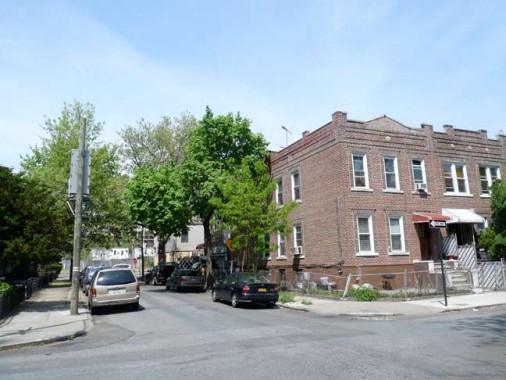
Friel Place at East 8th. The 2-story boxy brick buildings, one apartment each floor, are near standard issue in the NYC area.
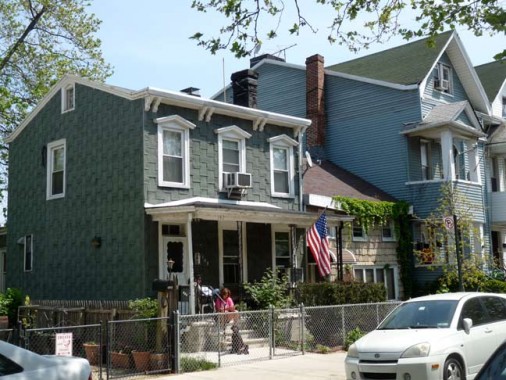
Likely one of the older houses in the neighborhood, on the portion of East 8th formerly known as 18th Street between Friel Place and Church Avenue.
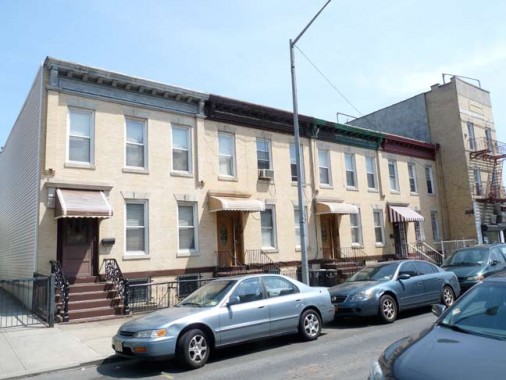
Two-story attached brick buildings on East 8th near Church Avenue. Note the original rail on the building on the left.
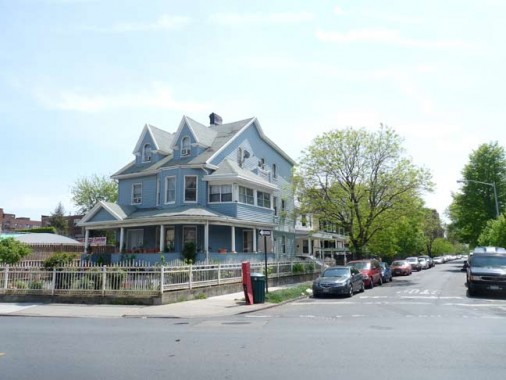
Church Avenue is a main shopping and business street in its entire length between 37th Street in Borough Park and East 98th in Brownsville. It was originally known as Church Lane as it led to the Reformed Dutch Church at Flatbush Avenue, a congregation founded by Peter Stuyvesant in the 1600s — its present building was erected in the 1790s and has tombstones in Dutch in its cemetery.
Oddly, Church Avenue follows a colonial-era path, and wobbles and weaves a bit in its eastern stretch instead of taking a straight path.
In the blocks between Ocean Parkway and Coney Island Avenue, you will occasionally find a large private home facing the street instead of the usual brick buildings with storefronts on the bottom and apartments on the top.
Turner and Hinckley Places
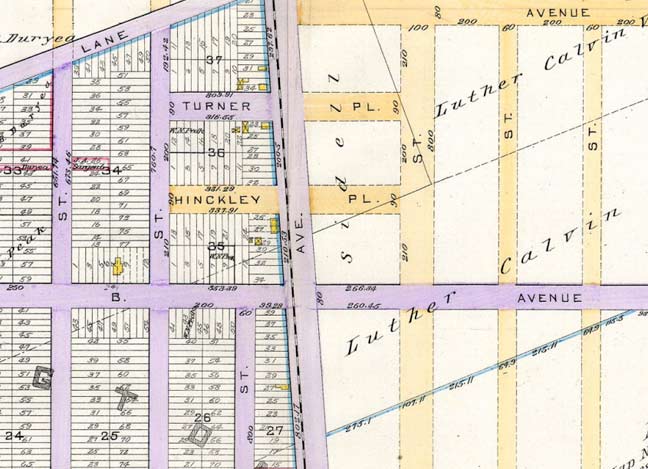
In the 1890s Turner and Hinckley Places, which run between East 8th and what was once East 11th, now Stratford Road, were already laid out and partially paved, though no homes had yet been built. Oddly they were laid out to cross busy Coney Island Avenue, which had a trolley route running on it that had been electrified in 1890; its origin was as a horsecar line. The B68 bus is its descendant.
Avenue B was renamed Beverl(e)y Road during a British-obsessed period when the region was being built up. Parts of Avenue C were renamed Clarendon Road, but another section in Kensington kept its old name. At the same time, portions of Avenue A and B in the East Flatbush-Canarsie area got to keep their letter names. The upshot of all this is that on the Brooklyn map, Avenues A and B are 3 neighborhoods and about 5 miles away from Avenue C. Only a map geek and a Brooklyn history geek, like your webmaster, understands why.
The Coney Island Plank Road was opened in 1850. The planks were removed in 1860 and the road was turnpiked and the horse cars began to operate over its line; this road is now known as Coney Island Ave. Coney Island History Project
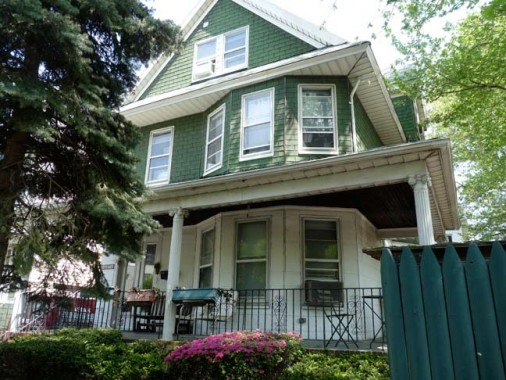
Large house with porch, NE corner East 8th and Turner Place.
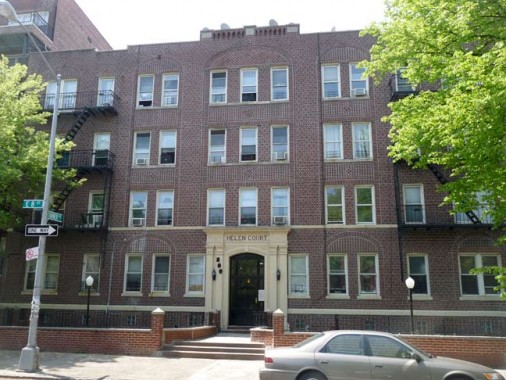
Helen Court, apartment building at the west end of Turner Place ay East 8th. You can see it on the 1929 atlas shown previously. I thought of the British Australian tennis champ, but that was Margaret Court.
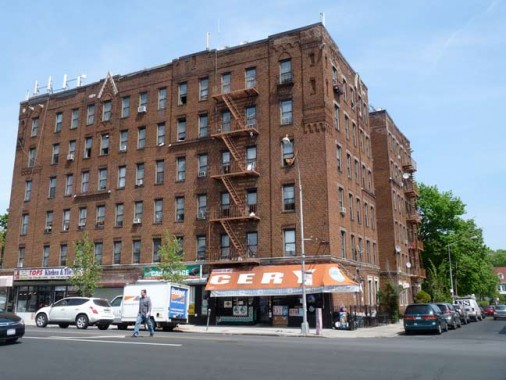
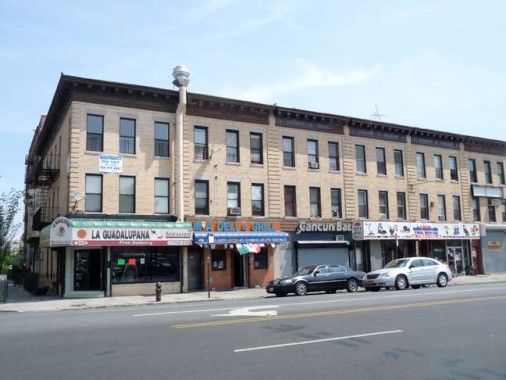
East side of Coney Island Avenue, north and south of Turner Place. These buildings likely date to the mid-1920s.
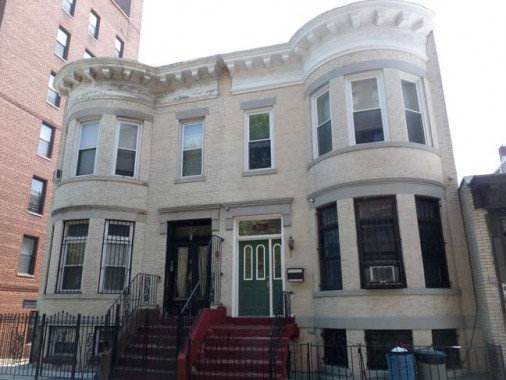
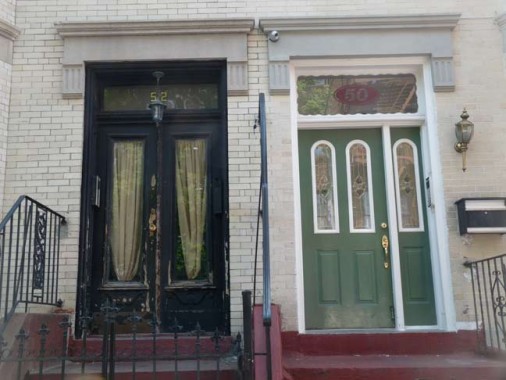
50-52 Turner Place. More often than not you see more units in a row like this, and they take up an entire block. Note that #50 has a new door, while #52 has what could be its original door.
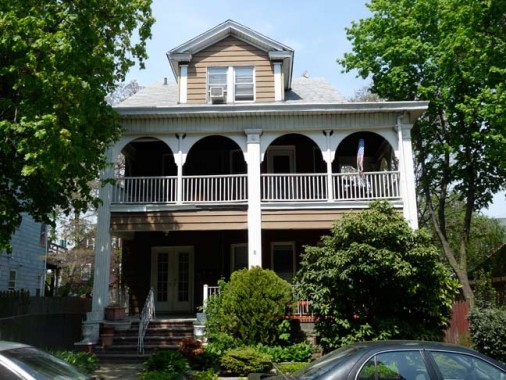
In Kensington, the duplex porch is a common style, almost the signature style of the neighborhood, especially along Beverley Road. Here is one example on Turner Place.
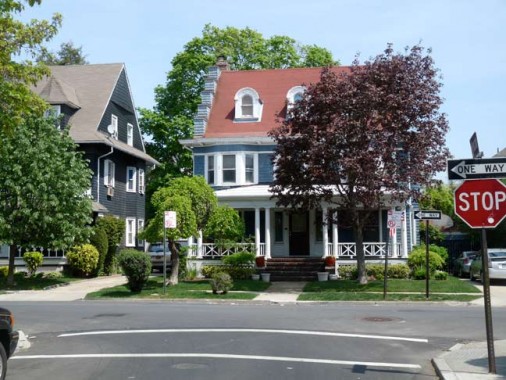
At Stratford Road we are almost on the doorstep of the landmarked Prospect Park South. In 2011, ForgottenTour #46 explored the incredible housing to be seen in the area.
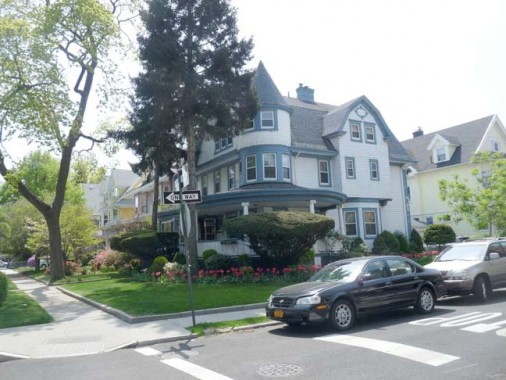
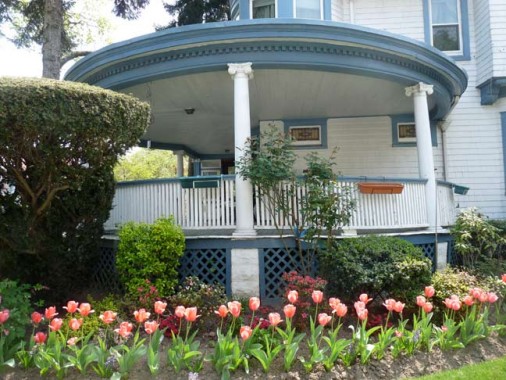
On the corner of Stratford Road and Hinckley Place, a building with a spherical, spacious shady porch almost negates the need for air conditioning in the summer for its lucky owners.
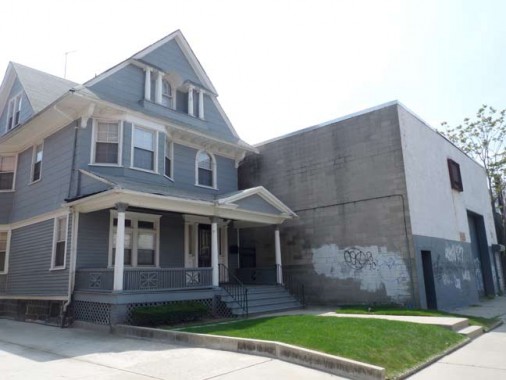
Compromise is the Hinckley Place theme, as the genteel housing of Prospect Park South gives way to commercial realities and cheaper warehousing.

Your home is your castle and there’s something to be said for the notion that you appoint your home as you see fit. That said, I wish there was more guidance and wisdom out there that would prevent situations like this Hinckley Place mistake from occurring.
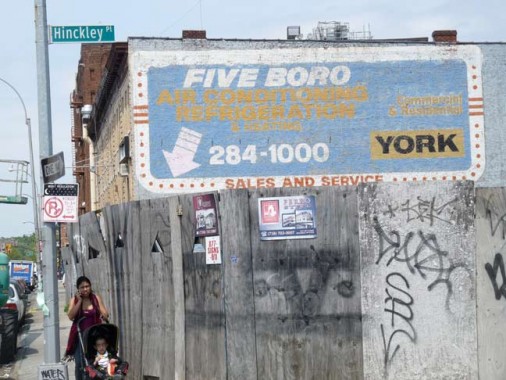
Painted ad on Hinckley and Coney Island Avenue that will be a classic in a few decades after tastes and styles in advertising ineluctably change.
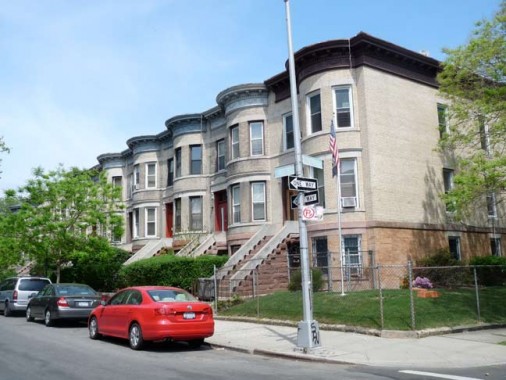
Remember the isolated attached homes at 50-52 Turner? More commonly they run in packs like this, on East 8th and Hinckley.
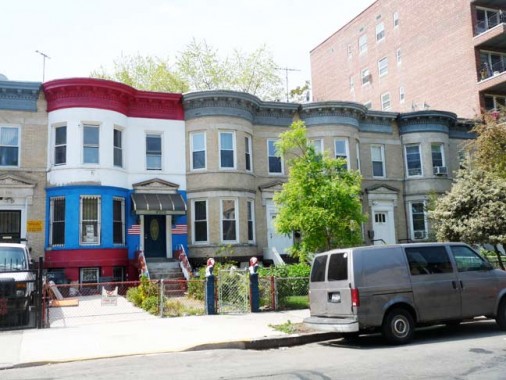
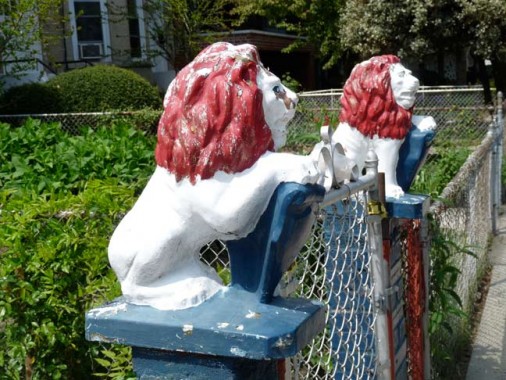
Far back as I remember, from when I lived in Brooklyn, this house on East 8th facing Hinckley has always had something going on with the presentation. Currently there’s a red, white and blue flag motif.
Massive apartment building at Beverley Road and East 8th features multiple doorways, with Ionic columns and, once again, British-sounding names, which apparently seem to impart a certain gravitas.
Lewis Place, Matthews Court, Slocum Place
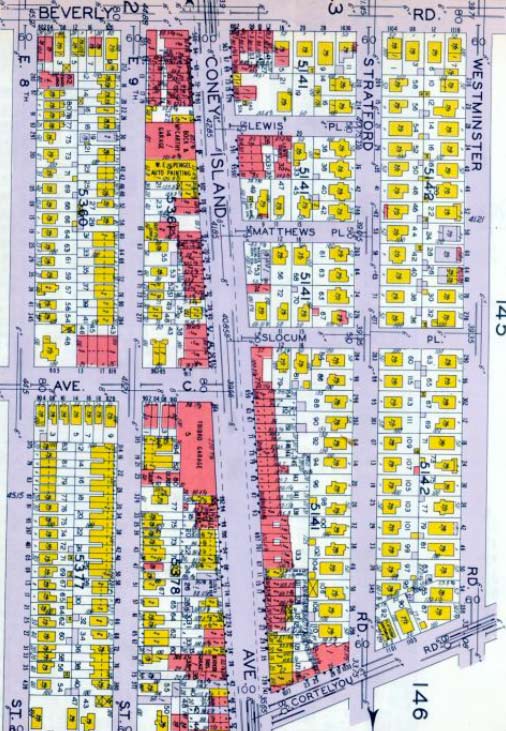
These three lanes don’t appear on the earlier 1890 map, and some modern maps make the mistake of showing all three as one block each. Slocum runs for two blocks, as on this 1929 atlas plate. Sometime and somehow between then and now, Matthews Place became Court.
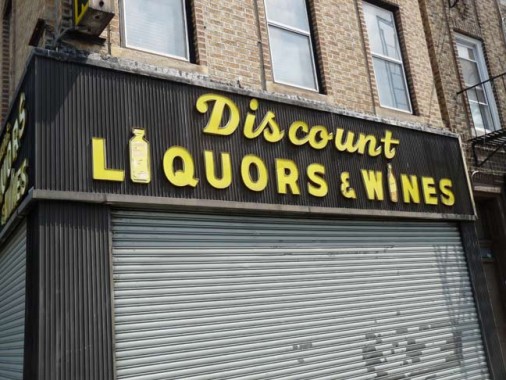
Discount liquors, Lewis Place and Coney Island Avenue. Note the liquor bottles replacing the letter I’s in the sign.

Quiet Lewis Place runs one block to Stratford Road. New bishop crook lamps have been installed in the Prospect Park South landmarked district, but unusually these have shallower than normal glass diffuser bowls.
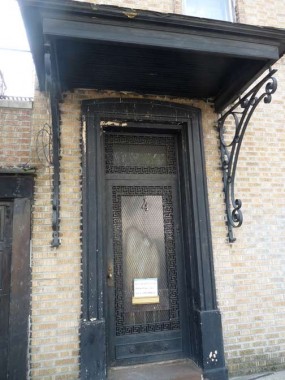

At #4 Lewis, actually part of the building with the liquor store on Coney Island Avenue, there’s a nice find: a doorway shelter with original scrolled metalwork. Nice stuff.
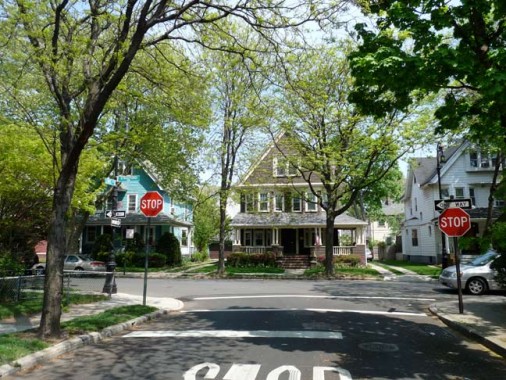
Lewis Place meets Stratford Road in a thicket of A-frames.
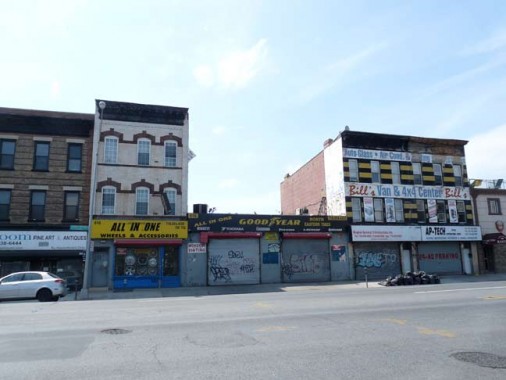

Matthews Court (not Place, like its brothers) meets Coney Island Avenue in a much more commercial gathering of painted ads and signs.
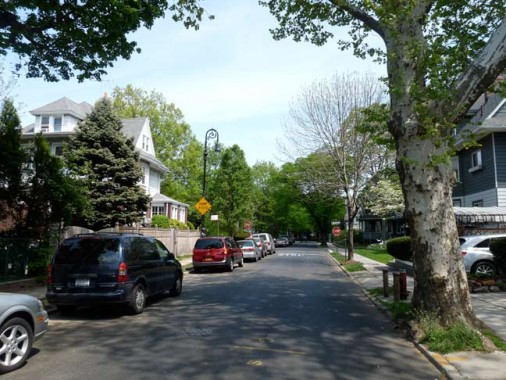
Slocum Place may or may not be named for Civil War General Henry Warner Slocum, who is also memorialized by a statue at Brooklyn’s Grand Army Plaza. The excursion steamboat named for him was involved in NYC’s worst disaster prior to 9/11/01.
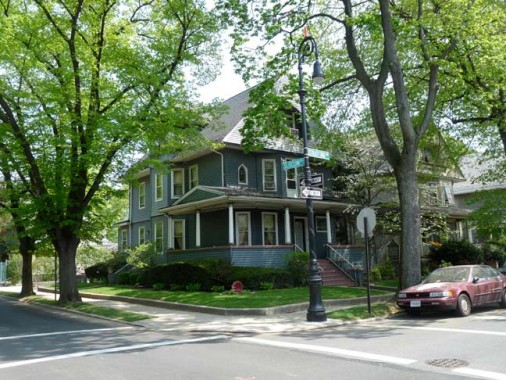
Shady villa at Slocum Place and Stratford Road.

Slocum Place goes the extra block, but ends, like this page, at Westminster Road.
7/21/12


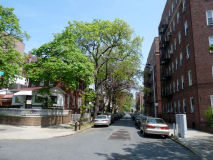
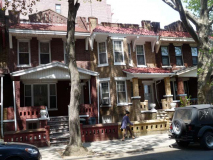

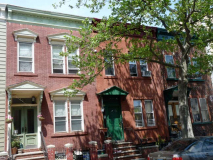
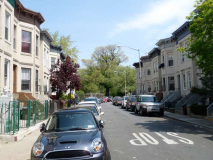
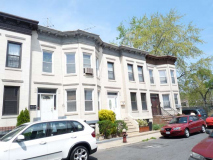
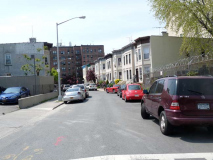

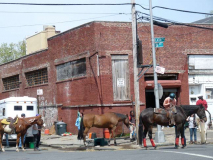
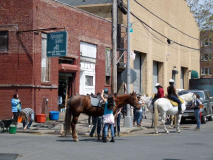
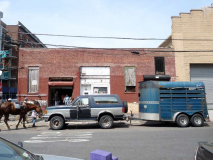
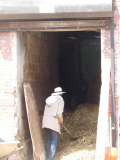
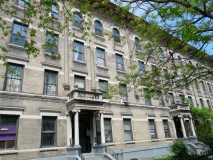
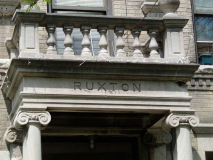
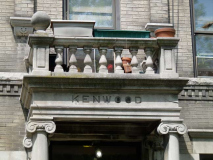
32 comments
Remembrance of Bowling Alleys Past is a good idea…so many are gone: jamar, ave m, bay ridge, elmwood, 3 star, rainbow, leemark,the orig gil hodges lanes,woodhaven, cross bay,midwood…
And Rollerama on 86st. They used to have WWWF wrestling downstairs. (Yes World Wide Wrestling Federation)
Does anyone remember Plaza Bowling Alley in the Park Slope area (at least) in the late 1940s and 1950s?
Nice to see my old neighborhood on FNY. I lived at 430 E. 8th Street, just north of Cortelyou Road from 1976 to 1984. That’s how I know that the International Baptist Church, on Caton and Coney Islland Avenue , was a funeral home catering to the local Jewish population.
I still live around the corner from where you lived Gary. If I remember correctly the funeral home was IJ Morris?
Margaret Court is an Australian tennis champion.
The bowling alley was Park Circle Lanes. Was comforting my Met pal there on a good season when the ball went through Buckner’s legs. 24 lanes (??) on one side? Was a great place to bowl. Closed between 1988-1991 or so.
20 lanes
I’ll never forget Kensington Stables and Park Circle Lanes. I was a 5th grader when I moved from East 7th Street between church ave and Beverly rd. Every chance I could I would ride my favorite pony (I think it was they only pony, she was a light color…blonde even) and they knew to get her when I came. And then I would go across the street to bowl. Happy memories back when I went to IHM catholic school…that’s gone too but nice to see church still there.
One of those big, wood-framed mansions that you photographed could well have been featured in the opening scenes of “Sophie’s Choice”, which was filmed around 1981. Also, I used to bowl at an alley on McDonald Ave. near Ave. I back in the 60’s. I think it was Elmwood Lanes, and it later became a ravioli factory.
“I think it was Elmwood Lanes, and it later became a ravioli factory.”
That’s actually not a bad trade-off.
Silver Star ravioli was next door to the bowling alley and stayed after Elmwood Lanes closed and became a furniture store. My friend, Rocco, used to own Elmwood Lanes.
It’s now a mental health outpatient facility. Across the street is Shop Rite which used to be Avenue I flea Market
[…] weekend Forgotten NY took a look at those short, one-way streets off of Coney Island Avenue between Church and Avenue C, as well as […]
On E. 10th st. between Caton and Church there is a very interesting building with what appears to be many bricked up arches. I believe the Coney Island Ave. facing side is now the medical center, but the E10th side looks like it must have been something very interesting. If you had any knowledge or opinions on what it could have been, I would love to hear. here it is on Google Street view:
https://maps.google.com/maps?oe=utf-8&client=firefox-a&q=maps+brooklyn&ie=UTF-8&hq=&hnear=0x89c2ed64fc3b013b:0xa3233f6e856bbeb3,Kings,+NY&gl=us&ei=iOAOUI3aAqne0QGjyoGIAQ&ved=0CAkQ8gEwAA
Re Bowling page, the three we used to go to were astoria lanes, 34th ave bowl and whitestone lanes. One or both of the last two may still be operating. Astoria lanes has an interesting history–The Grand Theater (movies) to Astoria Lanes to Key Food with Gym (The Rock). You can see the theater style roof from the side.
RS
I grew up on Kermit Place between East 8th St. and CIA . Included in the pictures were many areas I was well familar with- homes of family, friends and even my own. It was a great place to live in- lots to do with the bowling alley, roller skating rink, stables, Parade Grounds and Prospect Park all in our backyard. This place I will always consider home.. Thanks for posting and bringing back so many great and cherished memories!
Nice pictures,especially of the old maps,very interesting. My section is the Prospect Park South section of Flatbush and although I have knowledge of the distinction of the different sub-neighborhoods within Flatbush,most of the locals of the neighborhood,well mostly those on the “other side of the tracks” (the bridge between East 16th & Marlborough Rd.) don’t refer to the neighborhood as such. My parents have been in the area since the early 70’s (they’re from Bed-Sty) so they,along with myself have seen the drastic change in the scenery of the streets and so on. I spent alot of my youth in the 90’s walking down or running around or playing in or around all those streets,I know them like the back of my hand. Brought back alot of good memories.
I used to go to the bowling alley on E 18 St between Ave T and Ave U called Connie’s Ocean Recreation. which is now a bingo hall.
Very nice job of putting together both historical and present day facts about my former neighborhood. I grew up at 244 East Eighth Street at the intersection of Hinckley Place, and a better neighborhood for a child could not be found! Not sure when you, the webmaster, lived or visited, but dear friends lived in the row house that is now painted red, white, and blue, and I can assure you that when I resided there, there was nothing that would make that particular row house stand out from the others in the row. Not sure when the driveway and parking area were introduced or the interesting choice of exterior colors, but not before 1991 when my parents sold their home there. Thank you for such a comprehensive presentation along with historical comments.
Wow…. i like these wonderful well-kept victorian homes and styles. It removes the industrialised-type buildings so pre-dominant in mid-brooklyn and reminds folks that the borough was once one of prestige. So after those ugly warehouse style houses, then now we are having cigarette-box cheap, so-called “condos” being built in-between and around all the wonderful 1800s houses that bring charm to the area. I love these houses. The streets look like I have landed somewhere in Connecticut or something.
It truly is correct the perfect time to create a several options for the future and it’s also the perfect time to be happy. I study this specific post and if I could I must counsel you several attention-grabbing factors as well as tips. You could generate up coming posts referring to the next few paragraphs. My partner and i want to get more info things about them!
wow, great pictures…bring back so many memories. i would love to see more from dahill rd ,mcdonald ave,.13 ave and the very beginning of church ave below mcdonald ave. i grew up across street from BUZZ-A-RAMA-located on church ave between dahill road and story street ( another cool short street that streches from church ave to louisa street.. one block long.
BTW i bowled at Elmwood lanes on mcdonald ave and ave I ( right across from the Avenue I Flea Market) in the mid 70’s.
Then you must have known Rocky the owner.
Playing around with the idea of writing something about the 1970s, when I was living at 70 E. 8th Street. Started looking around the Internet for some photos to refresh my memory and found this. Amazing site. There was a factory on Caton Ave., between E. 8th and E. 7th. What did they manufacture there?
The factory you are referring to was known by 2 names when I lived at 158 E 8th just down from Church av from 1951 through 1976. The first name was “Hook and Eye” then “Atlantic Service”. The manufactured and restored / resharpened commercial meat cutting saws and knives. It was a small operation, but did a huge business. Some of my neighbors worked for that company and could be seen returning home for lunch at about noon. There was a ghastly smell from the basement level vented by fans out on to Caton Av. Many of the employees would take their lunch hour at Ryans Bar located directly across the street. This article brought back many memories of a lovely middle class neighborhood the likes of which will never be seen again. On Church av between E8th and Coney Island Av was Brown’s Mansion, which I was told was the main house of a farm- probably from the late 1800’s. I recall that it was torn down in the late 1950. We, as kids , were warned never to go into “Brown’s House” because it was haunted. Konwallers Pharmacy was on the corner of E8th and Church. “Doc” Konwaller was the sweetest, kindnest man God ever put on this earth. I recall getting a prescription filled there and was told by Doc “Tell your mother that this is a very expensive drug, and I’m giving it to her for my wholesale price” and apologized for the excessive price of $5.23.
Hi. I actually just moved to the Kensington neighborhood, but have always had a fascination with it since living in NY, so I will hopefully be making new memories! I’m curious about a small square structure on Hinckley St. next to the burned out “murder house” at 33 Hinckley. Does anyone know anything about when this house was built, or what it was, who built it, etc? I understand this lot is a site for a new school, the design of which doesn’t seem to fit the few blocks around it.
Hi,
You seem to know a lot about the streets of Bklyn and their history. I just learned that I may be related to a Susan Martense who married a Patrick Caton. It is said that part of her dowry was land that is now Caton Ave, and Caton place. I am a Caton descendent, so just wondering if Caton Ave, etc was named for this Caton family. Any info is much appreciated.
Sue K.
If you grew up in Kensington in the 1970’s-1980’s, where would you go o play basketball or swim? Were there any city parks with swimming?
Sunset park and Red hook had city pools
I’m am a wedding tonight in what used to be Elmwood Lanes. My father, brother & me bowled there in the ’60s. Glad we didn’t know Rocco, because my 12 year old older brother bowled so hard, that they had to fix the lane.
Looking for an old story in the daily mirror, possibly 1952 about boys going into prospect park zoo and swimming with the seals. Anyone familiar with the story? Thanks